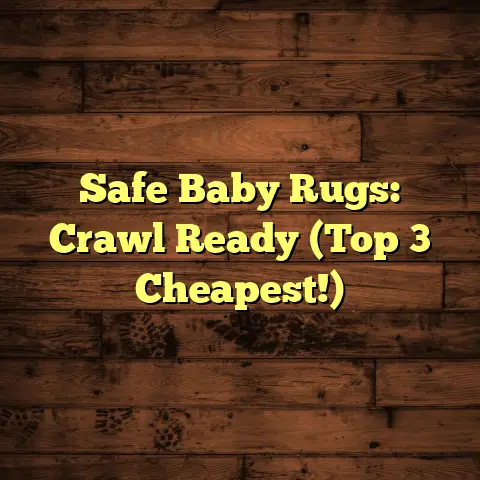Solutions To Clean Sticky Kitchen Floors? (Explained)
Did you know that sticky kitchen floors can be caused by a combination of simple spills and the natural oils from your skin?
I’ve seen this in countless homes, and it’s surprising how quickly it can turn a beautifully designed kitchen into a slippery mess.
As a flooring contractor with years of experience, I’ve faced my fair share of sticky floor challenges, and I’m here to share some effective solutions that I’ve found to work wonders.
Understanding the Causes of Sticky Floors
The first step in tackling sticky floors is understanding what causes them.
Over time, substances like food, grease, and cleaning products can build up on the surface of your flooring material.
For instance, when I installed tile in a client’s kitchen, they frequently cooked with oil, which inevitably splattered everywhere.
This residue can become a nightmare if not cleaned properly.
Another cause could be the cleaning products themselves.
I remember a client who used a multi-surface cleaner that left a sticky film on their laminate flooring.
It was frustrating for them because they thought they were cleaning effectively.
That’s when I realized the importance of choosing the right cleaning products.
The Impact of Flooring Material
Different flooring materials respond differently to sticky residues. For example:
- Tile: Generally easier to clean but can accumulate grime in grout lines.
- Laminate: Prone to stickiness from cleaners that leave residue.
- Vinyl: Can become discolored or sticky if wax is applied improperly.
- Hardwood: Requires gentle cleaning methods to avoid damage.
Understanding these nuances has helped me advise clients on how best to maintain their specific flooring type.
Solutions for Cleaning Sticky Kitchen Floors
1. Vinegar and Water Solution
One of my go-to solutions is a simple mixture of vinegar and water.
Vinegar is a natural cleaner that cuts through grease effectively.
Here’s how I typically do it:
- Mix: Combine one cup of white vinegar with one gallon of warm water.
- Mop: Use a microfiber mop to apply the solution to the floors.
- Rinse: After mopping, rinse the mop with clean water and go over the floor again to remove any vinegar residue.
I’ve used this method in various projects, and it works wonders.
Just make sure to test it on a small area first, especially if you’re working with hardwood or laminate floors.
2. Baking Soda Paste
For more stubborn sticky spots, baking soda can be a lifesaver.
I recall a particularly challenging job where a family had a lot of sticky residue near their refrigerator.
Here’s what I did:
- Create a paste: Mix baking soda with a small amount of water until you get a thick paste.
- Apply: Spread the paste over the sticky areas and let it sit for about 10-15 minutes.
- Scrub: Use a soft cloth or sponge to gently scrub the area before rinsing with water.
This method not only cleaned the sticky mess but also left the floors looking fresh.
3. Commercial Cleaners
Sometimes, homemade solutions aren’t enough, especially if you’re dealing with heavy-duty grime.
I’ve used several commercial cleaners over the years, but one that stood out is a non-toxic cleaner specifically designed for kitchen floors.
When using any commercial product, I always check for compatibility with the flooring type.
For example, certain cleaners can damage laminate or waxed hardwood.
Always read labels carefully!
4. Steam Cleaning
For those hard-to-reach areas or persistent residues, steam cleaning can be incredibly effective.
I’ve rented steam cleaners for larger jobs and found them to be beneficial in removing not just stickiness but also deep-seated dirt.
- Prepare: Fill the steam cleaner with water as per the manufacturer’s instructions.
- Steam: Move the cleaner slowly over the sticky areas, allowing the steam to loosen any grime.
- Wipe: After steaming, go over the area with a dry cloth to absorb any moisture.
Steam cleaning is particularly good for tile and sealed hardwood floors, but it’s not recommended for unsealed wood or laminate.
5. Essential Oils
In my experience, essential oils not only smell great but can also help when cleaning sticky floors.
A few drops of tea tree or lemon oil in your vinegar solution can enhance its effectiveness while adding a pleasant aroma.
- Mix: Add 5-10 drops of your chosen essential oil to your vinegar and water solution.
- Mop: As usual, use this mixture to clean your floors.
- Enjoy: Not only will your floors be clean, but your kitchen will smell fresh too!
6. Dish Soap Solution
For some sticky situations, dish soap can be an excellent choice due to its grease-fighting properties.
Here’s how I use it:
- Mix: Combine a few drops of dish soap with warm water in a bucket.
- Mop: Use a microfiber mop to clean sticky areas.
- Rinse: Follow up with clean water to ensure no soap residue remains.
This method is particularly useful after cooking sessions where grease has splattered everywhere.
Preventive Measures
Cleaning sticky floors is just one part of the equation; prevention is key to keeping your kitchen looking pristine.
Here are some practices I’ve found helpful:
Regular Maintenance
I cannot stress enough how important regular maintenance is.
Sweeping or vacuuming regularly helps remove crumbs and debris that can lead to stickiness.
I usually recommend my clients set aside 5-10 minutes daily for this task—it’s much easier than tackling a big mess later!
Immediate Clean-Up
Spills happen; cleaning them up immediately can prevent buildup.
Whenever I’m working in my kitchen and accidentally spill something, I make it a point to wipe it up right away.
This habit has saved me countless hours of cleaning later on!
Choose Appropriate Flooring
If you’re planning a renovation, consider materials that are easier to maintain.
For instance, tiles are generally easier to clean than hardwood in high-traffic areas.
I once had a client who opted for high-gloss laminate thinking it would look great—while it did look stunning initially, it showed every little smudge!
In hindsight, they would have preferred a matte finish for easier maintenance.
Using FloorTally for Cost Estimation
When it comes to renovations or new installations, I’ve found FloorTally incredibly useful in estimating costs accurately.
The platform allows me to input various materials and labor rates based on local averages.
For example:
When I recently worked on a kitchen remodel, I input all the specifics like square footage and material choice into FloorTally.
The estimates helped me provide my client with a transparent budget that included everything from installation to cleanup costs.
This transparency has significantly improved my relationship with clients, as they appreciate knowing exactly what they’re getting into financially.
Streamlined Budgeting
One of my favorite features of FloorTally is its ability to break down costs into specific categories—materials, labor, and even waste management.
It allows me to present clients with detailed estimates that they can easily understand.
For instance, during one project where we installed tile flooring in a large kitchen, FloorTally helped me estimate costs accurately down to the last detail, considering all potential variables like removal of old flooring and disposal fees.
Challenges Along the Way
Despite all these solutions, not every situation is straightforward.
I recall one project where my client had waxed their vinyl flooring without realizing that it would make cleaning nearly impossible.
We spent hours trying different methods before finally removing the wax layer entirely.
In another instance, I had a homeowner who believed that using too much cleaner would yield better results.
As it turned out, they only succeeded in leaving behind an even stickier mess!
Real-Life Scenarios
Let me share some real-life scenarios that highlight common issues encountered with sticky floors:
- The Greasy Kitchen: A family frequently cooked fried foods without proper ventilation.
The result?
A sticky film built up on their tile floor that required multiple cleaning methods before we finally managed to restore its shine. - The DIY Disaster: A homeowner decided to apply wax on their laminate flooring without realizing it wasn’t compatible.
The end result was a sticky mess that took several hours of scrubbing and re-cleaning before we could get it back to normal. - The Misused Cleaner: A client used an excessive amount of multi-surface cleaner thinking it would provide superior cleaning power.
Instead, it just left behind a residue that made their floors feel tacky—leading to yet another cleaning session!
Comparing Different Approaches
Over the years, I’ve tried various methods for cleaning sticky floors.
Here’s how they stack up:
In terms of effectiveness and cost-efficiency, vinegar and water often come out on top for regular maintenance.
However, when dealing with severe stickiness or grime, investing in commercial cleaners or steam cleaning may be worth it.
Practical Tips for Maintaining Clean Floors
To wrap things up, here are some practical tips based on my experiences:
Keep Cleaning Supplies Handy
Having your vinegar solution or baking soda ready can make cleanup easier.
I always keep a spray bottle filled with my vinegar solution under the sink—this way, I can tackle spills immediately without any delay.
Educate Family Members
Make sure everyone knows the best practices for maintaining floor cleanliness.
In one family home I worked in, we set up a chore chart that included daily sweeping duties which helped keep their kitchen tidy!
Schedule Regular Deep Cleans
Consider dedicating time every few months for deeper cleaning sessions.
This routine ensures that built-up grime doesn’t turn into an overwhelming task later on.
Use Mats
Place mats at entry points to catch dirt before it reaches your floors.
During one installation job at a busy family home, we placed rubber mats at all entrances leading into the kitchen—it made a noticeable difference!
Advanced Cleaning Techniques
If you’re looking for even more detailed approaches or specialized situations like removing specific stains or dealing with particular types of stickiness, consider these advanced techniques:
Removing Specific Stains
- Oil Stains: For oil spills or stains from cooking oils:
- Blot up excess oil using paper towels.
- Sprinkle cornstarch over the stain and let it sit for about 15 minutes.
- Vacuum up the cornstarch and clean the area with your vinegar solution.
- Sugar-Based Residues: If you spill something sugary:
- Mix warm water with dish soap and apply it directly onto the area.
- Scrub gently with a soft brush until clean.
- Wine or Food Coloring Stains: These can be particularly tricky:
- Blot up any excess liquid immediately.
- Create a paste from baking soda and water; apply directly onto the stain and let it sit for at least 30 minutes before rinsing off.
Dealing with Heavy Traffic Areas
High traffic areas often require extra attention since they accumulate dirt and stickiness much faster than other spots:
- Frequent Mopping: Increase your mopping frequency in these zones; consider doing this 2-3 times weekly instead of just once.
- Use Floor Protectors: If you have furniture that’s moved often (like stools at an island), invest in floor protectors to minimize scratches and stickiness where items rub against surfaces.
- Regular Waxing (if applicable): For certain types of flooring like hardwoods or vinyl tiles that are designed for waxing—make sure you maintain this schedule diligently as it helps create a barrier against dirt buildup.
Conclusion
Cleaning sticky kitchen floors doesn’t have to be a daunting task.
Whether you prefer DIY solutions or commercial products, there are plenty of effective methods at your disposal.
By understanding the causes and implementing preventive measures alongside efficient cleaning practices using tools like FloorTally for planning your renovations effectively—you can keep your flooring looking its best for years to come!
Remember that maintaining clean floors is not just about aesthetics; it’s also about safety in your home environment.
So roll up those sleeves and get started—your kitchen will thank you!





